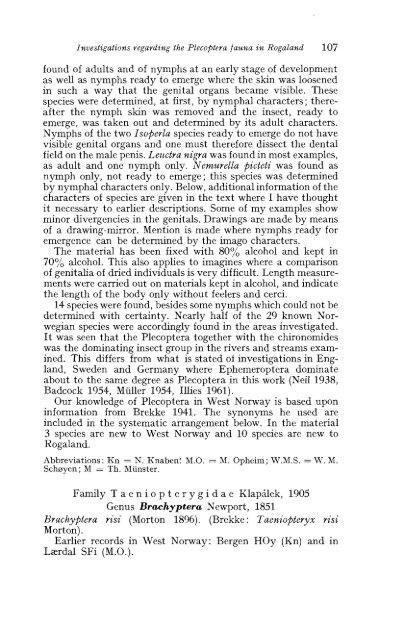NORSK ENTOMOLOGISK TIDSSKRIFT - Norsk entomologisk forening
NORSK ENTOMOLOGISK TIDSSKRIFT - Norsk entomologisk forening
NORSK ENTOMOLOGISK TIDSSKRIFT - Norsk entomologisk forening
You also want an ePaper? Increase the reach of your titles
YUMPU automatically turns print PDFs into web optimized ePapers that Google loves.
Investigations regarding the Plecoptera fauna in Rogaland 107<br />
found of adults and of nymphs at an early stage of development<br />
as well as nymphs ready to emerge where the skin was loosened<br />
in such a way that the genital organs became visible. These<br />
species were determined, at first, by nymphal characters; thereafter<br />
the nvm~h skin was removed and the insect. readv to<br />
emerge, wa; then out and determined by its adult LharaGers.<br />
Nymphs of the two Isofierla species ready to emerge do not have<br />
visible genital organs and one must therefore dissect the dental<br />
field on the male penis. Leuctra nigra was found in most examples,<br />
as adult and one nymph only. Nemurella fiicteti was found as<br />
nymph only, not ready to emerge; this species was determined<br />
bv nvm~hal characters onlv. Below. additional information of the<br />
cgarictirs of species are in the text where I have thought<br />
it necessary to earlier descriptions. Some of my examples show<br />
minor divergencies in the genitals. Drawings are made by means<br />
of a drawing-mirror. Mention is made where nymphs ready for<br />
emergence can be determined by the imago characters.<br />
The material has been fixed with 80% alcohol and kept in<br />
70% alcohol. This also applies to imagines where a comparison<br />
of genitalia of dried individuals is very difficult. Length measurements<br />
were carried out on materials kept in alcohol, and indicate<br />
the length of the body only without feelers and cerci.<br />
14 species were found, besides some nymphs which could not be<br />
determined with certaintv. Nearlv half of the 29 known Norwegian<br />
species were accordingly found in the areas investigated.<br />
It was seen that the Plecoptera together with the chironomides<br />
was the dominating insect group in the rivers and streams examined.<br />
This differs from what is stated of investigations in England,<br />
Sweden and Germany where Ephemeroptera dominate<br />
about to the same degree as Plecoptera in this work (Neil 1938,<br />
Badcock 1954, Miiller 1954, Illies 1961).<br />
Our knowledge of Plecoptera in West Norway is based upon<br />
information from Brekke 1941. The synonyms he used are<br />
included in the systematic arrangement below. In the material<br />
3 species are new to West Norway and 10 species are new to<br />
Rogaland.<br />
Abbreviations: Kn = N. Knaben: M.O. = M. Opheim; W.M.S. = W. M.<br />
Schayen; M = Th. Miinster.<br />
Family T a e n i o p t e r y g i d a e Klaprilek, 1905<br />
Genus Brachyptera Newport, 1851<br />
Brachyfitera risi (Morton 1896). (Brekke: TaenioPteryx risi<br />
Morton).<br />
Earlier records in West Norway: Bergen HOy (Kn) and in<br />
Lardal SFi (M.O.).

















